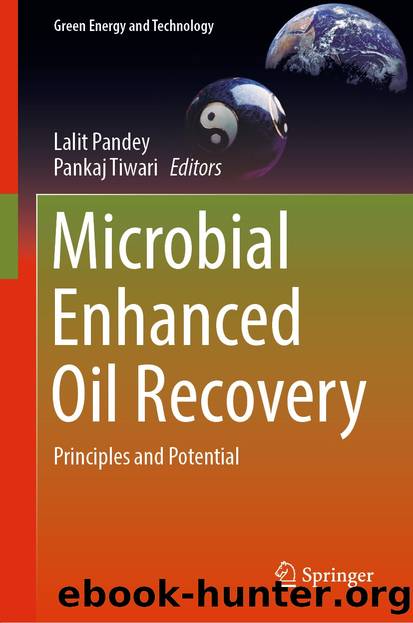Microbial Enhanced Oil Recovery by Unknown

Author:Unknown
Language: eng
Format: epub
ISBN: 9789811654657
Publisher: Springer Singapore
2.1 Properties of Crude Oil
Petroleum is a naturally occurring, complex organic mixture, comprising numerous components which can be mainly classified into the following types: alkanes (paraffins), cycloalkanes (naphthenes), aromatics, and more complex asphaltenes and resins. Crude oil is usually categorized into bitumens, heavy oils, medium oil and light oils based on American Petroleum Institute (API) gravity (Santos et al. 2014). Heavy crude oils are well-defined as liquid petroleum possessing 10â22.3° API gravity orâ>100 mPas viscosity in normal reservoir environments. Medium crude oil possesses API gravity of 22.3â31.1° and 33.4â100 mPas viscosity; light oil has an API gravity ofâ>31° and viscosityâ<33.4 mPas (Zhang et al. 2020a). The sequential degradation usually occurs following the trend of hydrocarbon susceptibility to bacterial degradation from light to heavy chain contents. The degradation rates of aliphatic hydrocarbons were established to be higher than aromatic hydrocarbons, which can be expressed in this order: aliphatic (linearâ>âbranched)â>âlight aromatic (mono aromatics)â>âcycloalkaneâ>âheavy aromatic (substituted or poly aromatics)â>âasphaltenes and resins (Sharma and Pandey 2020; Van Hamme et al. 2003).
MEOR technology was implemented mostly in the light conventional oil reserves largely in the USA, Russia and China from 1980 to 2010 (Belyaev et al. 2004; Youssef et al. 2009). But relatively less MEOR work has been done in heavy crude oil (density of 920â1000 kg/m3) reservoirs. The difference between heavy crude oil and traditional conventional oil are mainly high density, more complex composition possessing increased asphaltenes, resins, sulfur, nitrogen, and metal-containing compounds as well as low gas content and low hydrogen/carbon ratio. Heavy oil reservoirs can store about seven times more than conventional oil reservoirs (Leon and Kumar 2005). The largest heavy oil reservoir is located at the Orinoco oil belt of Venezuela. There are a number of heavy oil fields in Oman, where crude oil recovery is complex and expensive because of its high viscosity (Leon and Kumar 2005). The viscosity reduction of heavy oil facilitates improving oil retrieval from a reservoir due to improving the flow behaviour and minimizing the pressure drop (Santos et al. 2014). Different physical methods like heating and dilution are employed for this purpose (Santos et al. 2014).
The reduction in viscosity is also achieved majorly by two microbial mechanisms: either bioconversion of heavy into light oil fractions or by the production of microbial metabolites (e.g., biosurfactants) that modify the physical attributes of the oil, such as lowering its IFT. Several microbial isolates and produced enzymes contribute to the degradation of saturate and aromatic aerobically or anaerobically (Mbadinga et al. 2011; Nie et al. 2014; Rojo 2009; Widdel and Rabus 2001). Indigenous microflora can improve the fluidity of heavy crude oil by altering its high viscosity and subsequently forming lighter oil components (Pineda-Flores and Mesta-Howard 2001). Oil viscosity can also be reduced by produced CO2 gas (a byproduct of microbial metabolic activity), which creates pressure within the reservoir and push the crude oil upwards by fractional degradation of the large molecular components of crude oil. The produced biomass gathers between the oil and the well-rock surface and displaces
Download
This site does not store any files on its server. We only index and link to content provided by other sites. Please contact the content providers to delete copyright contents if any and email us, we'll remove relevant links or contents immediately.
| Automotive | Engineering |
| Transportation |
Machine Learning at Scale with H2O by Gregory Keys | David Whiting(4256)
Never by Ken Follett(3874)
Urban Outlaw by Magnus Walker(3361)
OPNsense Beginner to Professional by Julio Cesar Bueno de Camargo(3259)
Sapiens and Homo Deus by Yuval Noah Harari(3023)
Will by Will Smith(2863)
A Short History of Nearly Everything by Bryson Bill(2653)
Hooked: A Dark, Contemporary Romance (Never After Series) by Emily McIntire(2526)
Rationality by Steven Pinker(2321)
Borders by unknow(2278)
The Becoming by Nora Roberts(2144)
Holy Bible (NIV) by Zondervan(2099)
HBR's 10 Must Reads 2022 by Harvard Business Review(1817)
A Short History of War by Jeremy Black(1813)
The One Percenter Encyclopedia by Bill Hayes(1810)
Freedom by Sonny Barger(1782)
Go Tell the Bees That I Am Gone by Diana Gabaldon(1727)
Five Ways to Fall by K.A. Tucker(1722)
Girls Auto Clinic Glove Box Guide by Patrice Banks(1704)
